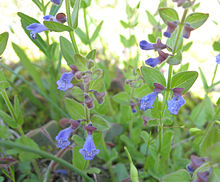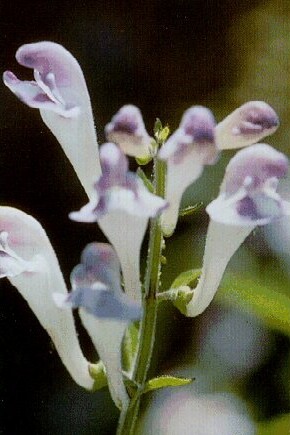
Scutellaria montana, with the common names largeflower skullcap, large-flowered skullcap and mountain skullcap, is a perennial forb first described by Alvan Chapman in 1878. This narrowly endemic species is found in the southeastern United States in parts of the Ridge and Valley and Cumberland Plateau Physiographic Provinces. Populations have been documented from four Tennessee counties and nine Georgia counties and is protected under the US Endangered Species act as it is a threatened species. The Latin specific epithet montana refers to mountains or coming from mountains.
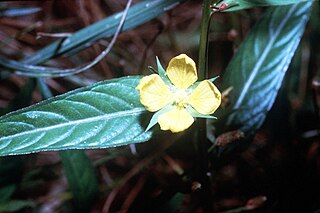
Ludwigia alternifolia, commonly known as seedbox, bushy seedbox, rattlebox, and square-pod water-primrose, is a herbaceous perennial plant of the family Onagraceae. It is native to central and eastern North America, growing in marshes, wet meadows, and swamps. It has yellow, four-petaled flowers and brown seed pods that are shaped like a cube.
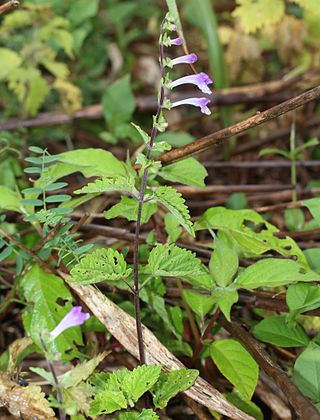
Scutellaria is a genus of flowering plants in the mint family, Lamiaceae. They are known commonly as skullcaps. The generic name is derived from the Latin scutella, meaning "a small dish, tray or platter", or "little dish", referring to the shape of the calyx. The common name alludes to the resemblance of the same structure to "miniature medieval helmets". The genus has a subcosmopolitan distribution, with species occurring nearly worldwide, mainly in temperate regions.
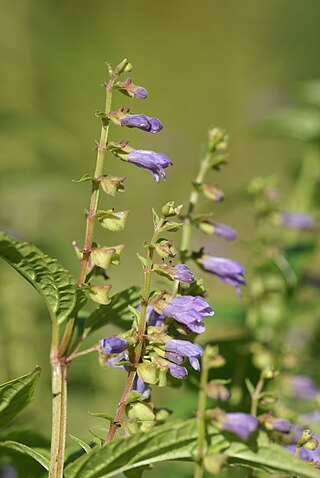
Scutellaria lateriflora, is a hardy perennial herb of the mint family, Lamiaceae, native to North America.

Scutellaria galericulata, the common skullcap, marsh skullcap or hooded skullcap, is a hardy perennial herb native to northern areas of the Northern Hemisphere, including Europe, Asia, and almost all of Canada. It is a member of the mint family. The form is upright and is usually 20-45 centimeters in height, sometimes reaching up to 80 cm. It is a wetland-loving species and grows along fens and shorelines. The blue flowers are 1 to 2 centimeters long. The flowers are in pairs and are all on the same side of the stem. The flowers do not appear at the top of the stem.

Scutellaria californica, the California skullcap, is a species of plant endemic to California. It is found in the scrub and low elevation mountains of Northern California.

Scutellaria ovata, commonly known as the heartleaf skullcap, is a member of the mint family (Lamiaceae). Its range in the United States is from Minnesota to Florida, and from Texas to the Atlantic coast. It is also native to Mexico.

Scutellaria nana is a species of flowering plant in the mint family known by the common names dwarf skullcap and dwarf scullcap. It is native to the western United States, especially in and around the Great Basin. It grows in plateau scrub, often on volcanic soils. It is a small perennial herb producing one or more erect stems up to about 20 centimeters tall from a rhizome. It is coated in tiny flat hairs which sometimes have resin glands. The leaves are oval or diamond-shaped, the lower ones borne on short petioles. Flowers occur in the leaf axils, each borne in a calyx of sepals with a prominent ridge on the upper surface. The corolla is up to 2 centimeters long, tubular in shape, and generally white or yellowish with purple mottling on the lips.

Eleocharis parvula is a species of spikesedge known by the common names dwarf spikerush, small spikerush and hairgrass in aquaria. It is a plant of brackish and saltwater habitat, such as marshes and mudflats. It is a perennial herb growing tufts of spongy, compressible stems not more than 10 centimeters tall. The plant grows from a tuber which is J-shaped or horseshoe-shaped, a characteristic that helps in the identification of the species. The inflorescence is an oval-shaped spikelet just 2 or 3 millimeters long, made up of several tiny flowers.

Scutellaria incana, the hoary skullcap or downy skullcap, is a species of perennial flowering plant in the mint family Lamiaceae. It is native to North America and is primarily found in the eastern United States as well as some parts of the Midwest.
Scutellaria siphocampyloides is a species of flowering plant in the mint family known by the common name grayleaf skullcap. It is endemic to California, where it is widespread throughout the mountain and coastal regions; it is absent from the deserts and the Central Valley. It can be found in forest and woodland habitat, and a variety of open habitat types. It is a perennial herb producing an erect stem or cluster of stems up to about half a meter tall from a system of thin rhizomes. The stems are coated in short, flattened hairs which sometimes have resin glands. The oval leaves are oppositely arranged. The lowest leaves are borne on short petioles. Flowers emerge from the leaf axils. Each flower is held in a calyx of sepals with a large ridge or appendage on the upper part. The tubular corolla can be up to 3.5 centimeters long and has a large upper and lower lip. The upper lip is folded into a beaklike protrusion and the lower has three wide lobes. The corolla is pale lavender to deep purple in color, sometimes with white mottling on the lower lip.
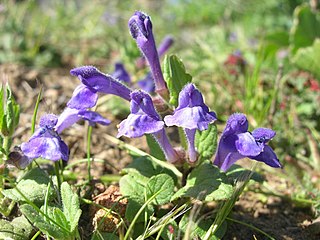
Scutellaria tuberosa is a species of flowering plant in the mint family known by the common name Danny's skullcap. It is native to western North America from Oregon through California to Baja California, where it is widespread throughout the mountain and coastal regions; it is absent from the deserts and the Central Valley of California. It can be found in forest and woodland habitat, and a variety of open habitat types, often appearing in areas recently cleared by wildfire. It is a perennial herb producing an erect stem or cluster of stems up to about 25 centimeters tall from a root system with tubers. The stems are coated in short, spreading hairs. The oval leaves are oppositely arranged. The lowest leaves are borne on short petioles. Flowers emerge from the leaf axils. Each flower is held in a calyx of sepals with a large ridge or dome-shaped appendage on the upper part. The tubular corolla is one to two centimeters long and has a large upper and lower lip. The upper lip is folded into a beaklike protrusion and the lower has three wide lobes. The corolla is deep purple-blue, usually with a white patch or mottling on the lower lip.

Lythrum alatum, commonly known as winged loosestrife, winged lythrum or angled purple-loosestrife, is a species of flowering plant belonging to the family Lythraceae. It is endemic to wetland areas in central and eastern United States and Ontario.

Alnus serrulata, the hazel alder or smooth alder, is a thicket-forming shrub in the family Betulaceae. It is native to eastern North America and can be found from western Nova Scotia and southern New Brunswick south to Florida and Texas.
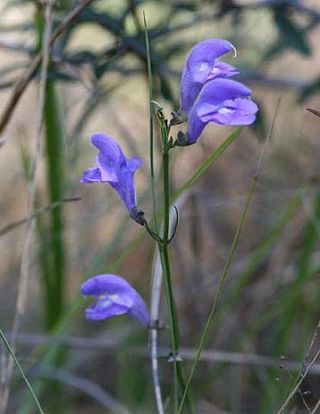
Scutellaria floridana, the Florida skullcap, is a rare species of flowering plant. It is endemic to Florida in the United States, where it is known only from the Florida Panhandle. It is threatened by a number of human activities and its small population sizes make it vulnerable. It is a federally listed threatened species.
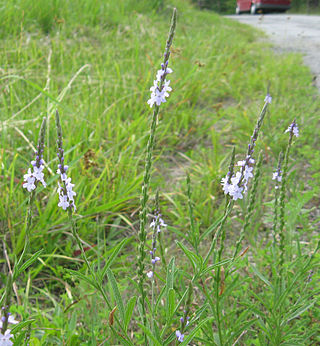
Verbena simplex, commonly known as narrowleaf vervain, is a perennial herbaceous plant plant in the Verbenaceae (vervain) family. It is native to central and eastern North America where it is found in open, dry, habitats on calcareous soil. It produces lavender flowers in the summer.
Brickellia parvula, the Mt. Davis brickellbush, is a North American species of flowering plants in the family Asteraceae. It is native to northeastern and north-central Mexico (Chihuahua) and the southwestern United States.
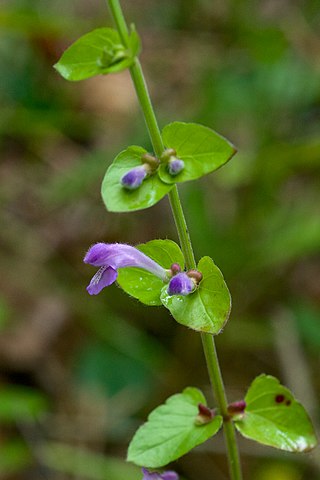
Scutellaria cardiophylla, known as gulf skullcap and heartleaf skullcap, is a species of flowering plant in the mint family. It is native to Texas, Louisiana, Arkansas, and Oklahoma; it is considered a rare/imperiled species across most of its range.

Scutellaria alabamensis, known as Alabama skullcap, is a rare and endangered wildflower, endemic only to 9 counties in North central Alabama.

Scutellaria elliptica, commonly called hairy skullcap, is a species of flowering plant in the mint family (Lamiaceae). It is a perennial forb found in the southeastern and mid-eastern states of the United States. It has blue flowers.
